The problem with VCC dropping uncontrolled is as follows. Erratic Behavior. Unstable Clocking. Brown-Outs. And Stalling. Or worse, corruption. Not even accounting for mismatched input voltages.
From the TI MSP430 FAQ, for starting up at too low a voltage
There are several common problems which prevent a MSP430 device having a problem during startup (device seems not to work at all):
Running CPU at higher frequency without adequate power supply
The most common problem is that the CPU is set to run at the higher frequency before the minimum supply voltage is reached. This problem occurs if Vcc is ramping relatively slowly than the default code which sets the CPU frequency. This information can be found in the device datasheet usually at the section "Recommended Operating Conditions".

In this case, the workaround would be to create a small delay at start-up before setting up the CPU to run at higher frequency, or to measure the Vcc using internal ADC to make sure that the appropriate Vcc level has been reached before running the CPU at higher frequency.
At Runtime:
Another problem might arise if the CPU is running at higher frequency and the supply voltage drops during run-time. In this case, it is advised to keep the device in reset state as long as the supply voltage drops below the adequate minimum voltage needed for running the CPU at the higher frequency. Failing to do so, the device can't be no longer guaranteed to work properly, and even it could cause severe damage such as flash memory corruption (refer to: MSP430_Flash_Best_Practices).
The referred to guide says:
Flash Corruption - Common Reasons:
Low VCC during an intentional execution of flash write/erase
It will not automatically clock down to adjust. No microcontroller will afaik.
Brownout does not apply here to a slowly ramping down battery
If VCC is above the V(B_IT-) voltage, the Brown Out Reset does not kick in. For the MSP430G25x3, the stated V(B_IT-) voltage is typically 1.35 Volts. Hysterics Vhys(B_IT-) or sometimes V(B_IT+) is 140mV typical over V(B_IT-). V(B_IT-) + Vhys(B_IT-) is equal to, or less than 1.8V. Typically 1.5 Volts. What this means is that a slowly discharging battery will not trigger a Brownout because it does not drop below 1.35 Volts. Everything from 1.799 Volts to 1.35 Volts will be undefined, funky, and lead to more issues. It's not intended to run that low.
Power On Reset is even lower.
Power On Reset applies at Vcc(Min) or Vcc(Start), which is 0.7 * V(B_IT-). Since that's normally 1.35V, the BOR voltage, POR Voltage is 0.945 Volts.
Oh, and intentionally dropping the voltage below what is needed can be used as an attack vector by hackers:
A disabled BSL may be bypassed by voltage glitching, a technique borrowed from Smart Card ‘Unlooper’ technology. An R/C circuit is charged to a voltage which is significantly less than the minimum required by the victim chip. If this is timed properly, faults may be introduced into the behavior of that chip, such as the skipping of a register write-back.
I suggest reading it just to understand what is happening. It's a short fun read.
That Said, it may still work below the stated minimum.
One guy took a msp430, and using super-caps to see how long it would last as a clock. Minimal speed, much time in sleep. Caps got to below 1.7V and it was still running.
UPDATE (10/11/2010): It's still running. Caps are down to 1.73V, which is below the msp's rated voltage, but it keeps spitting out numbers. I don't know if I'm more surprised that the processor is still running, or the LCD.
UPDATE (11/2/2010): Still freakin running. Caps are down to below 1.7V, hardly above the bias voltage on the LCDs, so you can hardly see the digits and they take half a second to really resolve.
